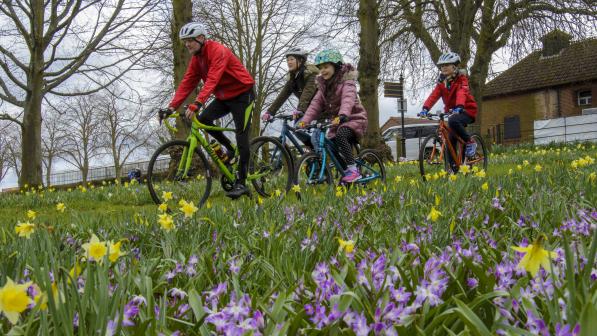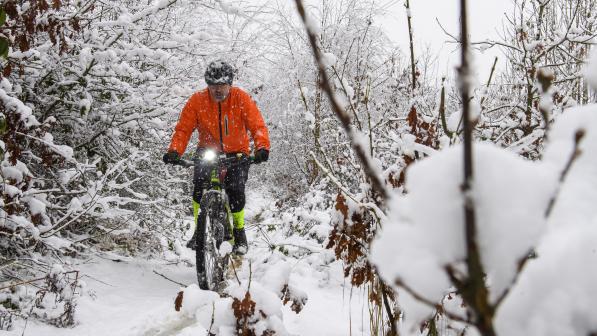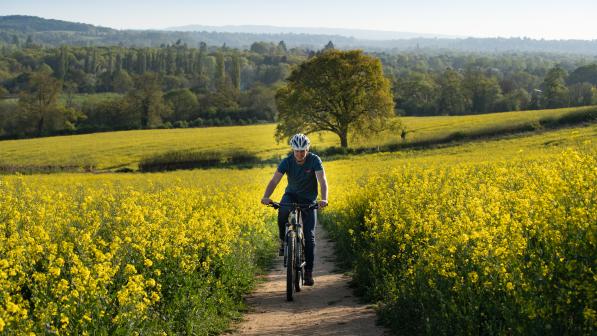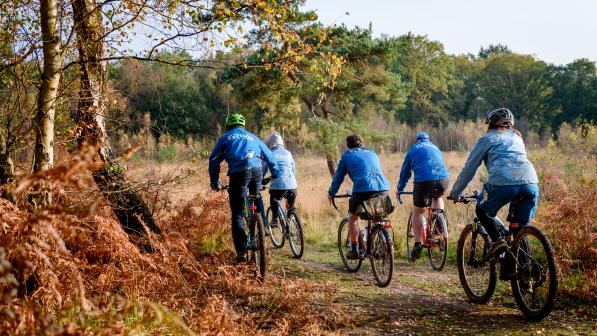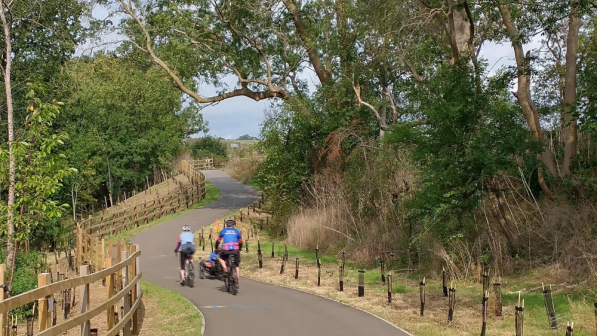What to wear for spring cycling

Longer days, warmer weather and – hopefully – more sun: spring is a great time to cycle. But the weather can be unpredictable, with freezing mornings, sunny afternoons, hot spells and rain showers, often in the same day. Crowded House’s Four Seasons in One Day might have been about the weather in Melbourne, Australia, but it could just as easily apply to spring in the UK.
This makes choosing what to wear while out cycling – whether that’s an all-day tour, a shopping trip or cycling to work – tricky. Getting it wrong can make your ride miserable: too much and you’ll overheat, not enough and you’ll be cold. Our advice will help you get it right.
General advice
Your watch words for spring cycle clothing are versatility and comfort. The former means you’ll be prepared for all eventualities, while the latter will keep you riding for longer.
It’s important to remember that there’s no single answer for everyone when it comes to spring cycling kit. Experiment a bit to work out what’s best for you and your riding style.
Spring weather is best described as changeable, so keep an eye on the forecast so you can plan accordingly. Be aware of where you’re cycling too. A day ride in a leafy woodland will be lovely, but even on a sunny day all that shade can mean it’s unexpectedly chilly.

Climbing will get you hot and sweaty even on cooler days, while descents can get cold – exposed arms are especially vulnerable. Early morning commutes can still be freezing, but by home time temperatures can be 10 degrees higher.
Consider your own riding style too. Are you the head down with a view to Strava records even on a trip to the shops type? I confess, that’s me. Or do you prefer to pootle along enjoying the scenery? Or maybe it depends on your mood.
On top
The key to spring kit is layering. Start with a lightweight short-sleeved base layer. You want something that wicks away moisture should you get sweaty but isn’t too heavy or hot. Merino is a good material for this and there are plenty of synthetics that also do the job well, but these can get a bit smelly. One tip is to check out hiking kit as well as cycling.
Go for a mid-weight short-sleeved jersey. You’ll appreciate the extra warmth of this – leave the lighter options till summer. For colder days you might want a mid-weight long-sleeved top or a soft-shell jacket that can go over your short-sleeved jersey. These are especially useful to pop on if you stop for a coffee or to fix a mechanical.
The bottom half
You can leave behind those thick winter tights and break out the shorts. Again, go for something of a medium weight. Three-quarter-length tights or leggings are a good compromise. These keep your knees covered and warm but still allow your lower legs to ‘breathe’.
For longer rides, good padded shorts are a must. They’ll protect your undercarriage and keep you comfortable in the saddle for longer. There’s nothing to stop you wearing them for short rides too. The more comfortable you are, the more likely you are to keep cycling.
Arm, knee and leg warmers
These incredibly useful accessories are much under-rated. They’re simple tubes of stretchy fabric with rubber grippers around the top to keep them in place. Paired with a short-sleeved jersey or shorts, they make for much more versatile kit than long sleeves or leggings.
Put them on for a chilly start and simply roll them down or take them off and put them in a pocket as temperatures rise. Arm warmers particularly are much easier to carry than a spare jersey if, for example, you’re cycling to work on a cold morning and then home again in the much warmer evening.

They’re also good if you’re tackling a lot hills. Push them down around your wrists for the climb, and then pull them up to keep your arms warm as you descend.
Leg and knee warmers turn your shorts into three-quarter or full-length tights, but with the bonus of being able to take them off when temperatures rise. Your knees are doing a lot of work when cycling and it’s important to keep them warm, otherwise you risk injury.
The trick is to find a pair with grippers tight enough to keep them in place without cutting off the circulation, while being long enough to cover everything they’re supposed to. Different brands will have slightly different sizes so it’s worth trying out a few to find what works best for you.
They also come in a range of different materials; some are thermal. A variety of patterns and colours are available too, so they can be a good way to brighten up a dull outfit.
Vest interests
Keeping your core warm is key to comfortable spring riding. This is where a vest or gilet comes in. These sleeveless, lightweight garments are made of a windproof material on the front to keep your chest warm, with a breathable fabric on the back, often with mesh segments, to stop you overheating.
The front of your body bears the brunt of the wind and rain so keeping your chest and stomach warm and dry will help keep the rest of you toasty.
A gilet provides an extra layer on cooler days without being too bulky. They’re also great for going downhill or to pull on if you have a stop. They’re much smaller than a jersey so are easy to roll up and put in a pocket when no longer needed – and then pull out again when the sun goes behind a big cloud.
Stay dry
A heavy-duty waterproof jacket or rain cape will have served you well over winter. But you’ll soon find they’re too much in spring. As the weather gets warmer you don’t want to be sweating under a thick jacket – that defeats the point of wearing it! – while jackets and capes aren’t the most packable of items. They’re simply too bulky to fit in pockets or small bags.

A good lightweight waterproof should keep you dry in all but the heaviest of showers, while still being small enough to roll up and pop in a pocket. Look out for ones with venting so you don’t feel like a boil-in-the-bag chicken.
Get buff
A neck warmer – otherwise known as a buff – is a very versatile piece of kit. A simple tube of fabric, it provides protection from cold and wind in that gap between your jersey collar and a helmet or cap.
It can also be pulled up to cover your ears or even used snood-like under a helmet to keep your head warm. Much like arm and leg warmers, it can easily be taken off and stashed away in a pocket if conditions improve.
Taking care of hands and feet
You can probably ditch the heavy winter gloves now, but it’s almost certainly too early in the season to go straight to fingerless mitts. A pair of lightweight, full-fingered gloves will see you right. Make sure they’re water and windproof too – cold, wet hands will make any ride miserable.
Similarly, you can leave the winter boots and thick overshoes at home, but you still want to ensure that your feet stay warm and dry. On dry days a nice pair of merino socks with your usual cycling shoes should do the trick. There are some brilliant designs out there from the likes of Stolen Goat and DeFeet – go wild!
On wetter days a pair of oversocks – otherwise known as Belgian booties – might be a better choice. These tightly woven, sturdy socks go over your cycling shoes and will protect your feet from cold wind and showers.
The eyes have it
Sunglasses aren’t just for keeping the sun out of your eyes – although they are very good at that, too. On a bike they also protect your eyes from bits of debris in the air and the rain.
At this time of year, conditions can go from bright and sunny to dark and drizzling in a matter of hours. A pair of cycling sunglasses with interchangeable lenses are ideal in this situation as you can go for photochromatic lenses.

However, these can be very expensive. A pair of normal sunglasses with pink or yellow lenses should shade your eyes from the UV rays while being light enough to see if it suddenly gets cloudy.
Some final tips on getting the right kit
- Cycle clothing tends to be quite close fitting. You might want to size up so you can wear a few layers
- Clothing that folds down well will fit into a pocket where it’s easy to get to if you need it again
- Keeping tools, snacks and so on in bags means you can save pockets for your clothing
- Canny use of accessories means you can extend the life of your winter and summer kit – saving a bit of money
- You don’t have to buy dedicated cycling gear – take a look at outdoor and hiking clothing too
- As the days get sunnier, it’s a good idea to use sunscreen
- Cycling UK members get discounts with a range of cycling and outdoor brands, so check them out before you buy! If you’re not already a member, join today for instant access to savings
Now you’re kitted out for spring, make sure your bike is ready too!

